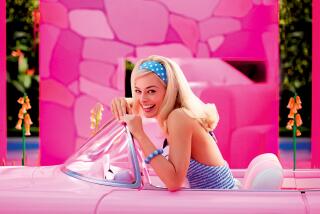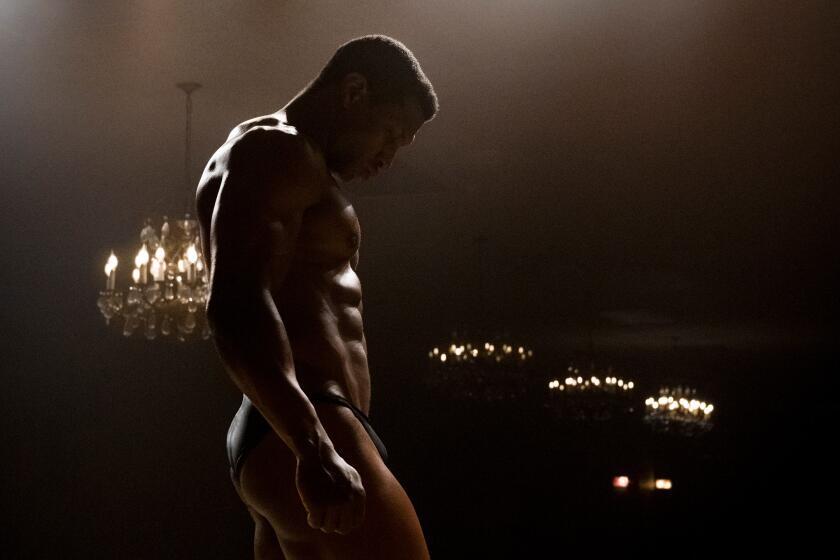This Cartoon’s Got Legs--and Hips Too
- Share via
The female protagonists in “Lilo & Stitch,” Disney’s new animated movie about a lonely little Hawaiian orphan being raised by her older sister, are such a relief. A relief from the amplified female physiques of bodacious cartoon babes the likes of Pocahontas, Ariel (“The Little Mermaid”) and Esmeralda (“The Hunchback of Notre Dame”) to name a few. Lilo, the little girl, and her 19-year-old sister, Nani, are rendered with sturdy, softly rounded bodies, thick thighs and, in Nani’s case, ample hips, physiques that resemble real bodies of real girls. Refreshingly, Lilo looks like a child, not a diminutive woman.
It was no accident. “Chubbing things up” was the expression the film creators used when directing animators to stay true to the original drawings of the film’s writer and co-director Chris Sanders, according to the studio.
“It created a lot of excitement in the studio because there’s almost a female shorthand that you get used to sometimes in the animated world,” Sanders told the Chicago Tribune. “And [our characters] defied all that.” Parents and feminists alike have long complained about the unrelenting parade of ridiculously perfect-bodied female characters in children’s animated films, arguing that such images of the female form and the implied messages (i.e. beauty takes all) are unhealthy, narrow models for little girls and adolescents.
But what effect, if any, does seeing chubbier female characters have upon the developing body image of a little girl or tween sitting in the theater?
“The research on the media’s impact on women and girls’ relationship to their bodies shows that it is profound,” said Melanie Katzman, clinical assistant professor in psychiatry at Cornell Medical Center in New York City. “It shapes visual expectations about how one expects others as well as oneself to look. Any alteration in those images is going to have an impact. But any degree of impact is going to be in direct relation to the character’s similarity to the viewer.” There may be several degrees of separation between characters in an animated movie and a young viewer, Katzman said. The first is that the characters are animated instead of human. Second, the female protagonist may be of a different ethnicity. And last, the characters may inhabit a fantastical environment.
“The female characters in ‘Lilo & Stitch’ are a step in the right direction but it is not enough on its own,” Katzman said. “There would be a bigger impact by fattening up the women characters on ‘Friends.’ There really has to be a cumulative effect.” In an experiment at an eating disorders conference two years ago, Katzman said, clinicians experienced a simulated cumulative effect when they were deluged with beautifully rendered images of obese bodies, then shown a fashion model. The fashion model looked ill in comparison, Katzman said.
This is the operating principle at work with many young girls and women who compare their bodies to the dominant cultural ideal of the impossibly perfect female form. When their bodies don’t match, they try to conform.
Katzman conducted a study of 93 Chinese college sophomore women who came to Los Angeles from Hong Kong. After living in Los Angeles awhile, the women began exhibiting more disturbed eating behaviors (i.e. starving themselves, weighing themselves often, using laxatives to lose weight and comparing their bodies) than their Hong Kong counterparts, according to the study, published in 1999 in the Journal of Eating Disorders.
“One of the available ways for these women to fit in and assimilate was to join in conversation about body weight and to compare their bodies to others,” said Katzman, author of “Eating Disorders and Cultures in Transition” ( Rutledge, London, 2001). “When in your own culture, you reference or identify with your own [culture’s ideal body image] but when you are in another, you reference the other.” Girls and teenagers are particularly vulnerable to cultural definitions of physical attractiveness partly because they haven’t developed a solid sense of self yet.
“Girls, tweens and teenagers often look at the media for what is good and what is attractive and most of these animated characters in movies are like a rendition of Barbie,” said Anne Kearney-Cooke, a clinical psychologist at the Cincinnati Psychotherapy Institute who specializes in body image and eating disorders. “Girls compare themselves, feel bad, develop eating disorders and exercise trying to conform. It can be freeing for girls to see lots of images and different ethnic groups.” Aside from the fact that the characters Lilo and Nani possess sturdier bodies that are more instrumental and less ornamental, Lilo looks and dresses like a little girl.
“It is important that not only is it not a perfect female form but that it is childlike,” said historian Joan Jacobs Brumberg, Stephen H. Weiss Presidential Fellow and professor of Feminist, Gender, & Sexuality Studies at Cornell University. “So the little girl watching doesn’t feel that she has to be precociously mature and has to look like a grown-up woman. That way the image doesn’t contribute to more of that premature insane anxiety adolescent girls now have about their bodies.”
Brumberg knows the subject well. She is the author of the 1989 book “The Body Project: An Intimate History of American Girls,” which examined adolescent girls’ diary excerpts and media images from 1830 to the 1990s. She found that girls at the turn of the 19th century measured their self-worth on good deeds and internal character whereas girls at the end of the 20th century were concerned with the “shape and appearance of their body as a primary expression of their individual identity.” By age 13, 53% of girls are dissatisfied with their bodies, Brumberg writes, and many have begun a pattern of dieting as early as 8 or 9.
“We want to aim for as much variety [of images of girls] as possible for the health of all girls, especially that generation of girls who cut their teeth on Britney Spears,” said Brumberg. “It would be lovely if [the entertainment industry] could make that transition to more variety with human actors. Girls certainly need some kind of alternative vision, otherwise it is one blond-haired, midriff-bearing woman after another.”
More to Read
Only good movies
Get the Indie Focus newsletter, Mark Olsen's weekly guide to the world of cinema.
You may occasionally receive promotional content from the Los Angeles Times.









